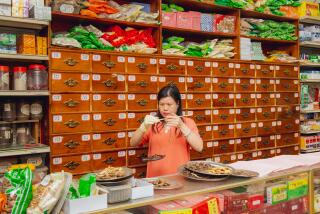Where the food is meant to soothe
- Share via
At Herblife Restaurant in Temple City, customers order chicken-ginseng soup for an energy boost. At Nature Pagoda in San Gabriel, they might ask for dried scallop broth full of translucent chunks of winter melon. Many a Chinese grandmother will assure you that such dishes can ward off all sorts of ailments.
Although Chinese therapeutic cooking traditionally has been practiced in homes, there has been a wave of health restaurants in Hong Kong, Singapore and Taipei, some of them with highly respected gourmet chefs, and the trend recently has reached the Southland.
Many of the dishes these health restaurants specialize in are simply broths, rice porridges or cooked dried fruits; others include medicinal substances loosely called herbs. Can they truly taste good? “Absolutely,” says Grace Young, whose cookbook, “The Wisdom of the Chinese Kitchen,” has two chapters on curative foods.
Herblife is as plain as a pin, the lower part of its walls painted a soothing pale hospital green. Its 100-item menu of central and western Chinese home-style dishes includes 21 “House Specialties” incorporating medicinal berries, roots, seeds, barks or mushrooms. Shrimp with tofu and lily bulb slivers comes in a glistening garlic and chile sauce that unites the flavors beautifully. Nickel-size slices of Chinese yam and thin-cut beef strips absorb the meaty, peppery juices of the beef with black pepper sauce, intended to nourish the kidneys. Astragalus-steamed fish bubbles away at the table on a little burner, its clear, tart-sweet broth absorbing astragalus (a legume root) and other herbal matter meant to boost energy and enhance the immune system.
On the menu page devoted to tonic soups, Herblife’s owner, Hamilton Chou, has gone to the trouble of describing the purported benefits of each in English. They’re based on flavorful, long-simmered stocks made without salt, soy sauce, MSG or any apparent fat.
A soup may seem bland at first, but after several sips the flavors come into focus. In ginseng-chicken and dried bamboo soup, the spongy squares of bamboo absorb the delicate liquid, giving each bite a rich mellowness. Nutty-tasting Job’s tears (a barley-like grain thought to be cleansing) adds body to several soups. Fleece flower with pork rib soup (said to strengthen the eyesight and lower back) contains bark-like slices and tiny, bright orange wolfberries, which lend a trace of sweetness.
With its modern casual room, spiffy logo and Cantonese orientation, Nature Pagoda has the look of a modern Hong Kong coffee shop. Its four major menu sections offer soups, rice hot pots, medicinal teas (infusions of various sorts) and even herbal desserts. Several dishes are based on exotic ingredients such as crocodile meat and ground tortoise shell.
Soups made from black bantam chickens, prized for their intense flavor, are a specialty here. These broths have a reputation as a blood tonic, especially favorable to women and the elderly. The rich chicken taste comes through in the black chicken with ginseng soup, but medicinal flavors permeate the version with four mixed herbs and predominate in the one with eight mixed herbs.
With some soups, such as the soft-shelled turtle, you’d have difficulty extracting meat from the bones, but the broth is sumptuous and worth sampling for its delicate flavor. Many customers drink only the broth anyway.
The rice hot pots, with their crunchy rice crust at the bottom, are warming comfort foods believed to help balance yin and yang. Most are quite light, particularly the sauteed chicken with black fungus (cloud ear mushroom) hot pot and the catfish filet hot pot, with a smoky edge from its black bean sauce.
Of the teas, five-flower tastes a bit like prune juice, especially if you sweeten it. The sweet and tart hawthorn berry tea has a medicinal tinge, like a European herbal digestif.
Even desserts have healthful reputations. They’re mostly puddings and sweet fruit-flavored soups such as papaya or Asian pear, steamed with bland, slightly crunchy white fungus.
Of all the dishes I tried at either restaurant, Herblife’s lamb hot pot (listed in Chinese on the back page as No. 1) was the most spectacular. Lean lamb chunks and soft chewy strands of lamb skin come in a clean, light broth, with a savory-sweet condiment to swirl in just before eating. The dish will beautify your skin, says Chou -- a selling point not needed by those interested only in its terrific flavor.
*
Herblife Restaurant
Location: 4815 El Monte Ave., Temple City; (626) 279-7558.
Price: Soups, $3.25; main dishes (serves three or four), $4.55 to $6.95 (lunch) and $6.95 to $8.95 (dinner).
Best dishes: Lamb hot pot, shrimp with lily bulb and bean curd, astragalus-
steamed fish.
Details: Lunch, 11 a.m. to 3 p.m. daily; dinner, 5:30 to 10 p.m. daily. No alcohol. Parking lot. Cash only.
*
Nature Pagoda
Location: 312 W. Valley Blvd., San Gabriel; (626) 570-8333.
Price: Soups, $5.95 to $11.95; rice hot pots, $5.95 to $13.95; teas, $1.50; desserts, $1.95 to $2.85.
Best dishes: Black chicken soup with ginseng, chicken with black fungus hot pot, steamed pear with white fungus.
Details: Open noon to 11 p.m. daily. No alcohol. Parking lot. MasterCard, Visa, Discover.
More to Read
Eat your way across L.A.
Get our weekly Tasting Notes newsletter for reviews, news and more.
You may occasionally receive promotional content from the Los Angeles Times.










